Molecular Simulation Study on the Aging Mechanism of NEPE Propellant Matrix
Abstract
:1. Introduction
2. Results and Discussion
2.1. Aging Reactions of Binder
2.1.1. Decomposition Reaction
HOCHCH2 (P1) + HOCH2CH2OH (P2)
2.1.2. Nitration Reaction
HOCHCH2 (P3) + HOCH2CH2ONO2 (P4)
2.1.3. H Abstraction Reaction
OHCH2CH2OCHCH2OH (P5) + ONHO (P6)
OHCH2CH2OCHCH2OH · (P7) + HONO (P8)
2.1.4. Oxidation Reaction
2.1.5. Crosslinking Reaction
2.2. Aging Reactions of Curing Agent
2.3. Analysis of Matrix Aging Mechanism
3. Methods of Simulation and Calculation
3.1. Quantum Chemistry Simulation Methods
3.2. Calculation of Chemical Reaction Rate Constants
4. Conclusions
- (1)
- The results of transition state calculations of aging reactions of NEPE propellant binder showed that the reactions could be divided into five types: decomposition, nitration, H abstraction, oxidation, and crosslinking reactions. Among them, H abstraction and oxidation reactions under the action of NO2 and O2 had lower energy barrier and faster reaction rate, which were the main reactions for aging of binder. The bond energy of C-O in the binder molecule was high and, thus, more difficult for homolytic reactions to occur, resulting in a higher reaction energy barrier and slower reaction rate for decomposition and nitration reactions. This was a secondary aging reaction mode for the binder. As the H abstraction and oxidation products contained alkyl and alkoxy radicals, respectively, their products could not exist stably and were prone to crosslinking reactions without potential barriers and driven by electronic effects, which increased the molecular weight of the binder and formed a network structure.
- (2)
- For NEPE propellant curing agent aging reactions, transition state calculations showed that the main cause of curing agent aging was C(O)-N and C-O breakage and, after homolysis, active free radicals (NHC(O)O· and RNH·) and alcohols generated, and CO2 released at the same time. All three curing agent aging reactions damaged the long chain structure of the matrix to some extent and caused the gradual appearance of local holes and microcracks in the matrix. Compared with the binder aging reactions, the three curing agent reactions had higher energy barriers and, thus, were more difficult to react.
- (3)
- Calculations of the energy barriers and rate constants of different aging reactions of NEPE propellant matrix showed that the aging of the matrix could be divided into two stages: in the first stage, H abstraction and oxidation reactions of long chain binder molecules occurred under the action of NO2 and O2, and active radicals generated by H abstraction and oxidation reactions easily combined with each other to produce crosslinking reactions, resulting in a sharp increase in binder molecular weight and an upward trend in the maximum tensile strength. This aging process mainly occurred in the middle stage of propellant aging, when most of the antioxidants had been consumed and the products of plasticizers and oxidizers started to gather in large quantities. In the second stage, the decomposition reaction of binder and curing agent occurred, which, on one hand, destroyed the curing network and crosslinking network of the matrix, and on the other hand, CO2 released by the decomposition reaction caused a porous structure and holes in the matrix during the process of diffusion and aggregation in the matrix. Under the joint action of both factors, the mechanical properties of NEPE propellant matrix showed a significant decline in the late aging stage.
Author Contributions
Funding
Institutional Review Board Statement
Informed Consent Statement
Data Availability Statement
Acknowledgments
Conflicts of Interest
Sample Availability
References
- Pang, A. Theory and Engineering of Solid Rocket Propellants; China Astronautic Publishing House: Beijing, China, 2014; pp. 129–137. [Google Scholar]
- Voorhees, K.J.; Baugh, S.F.; Stevenson, D.N. An investigation of the thermal degradation of poly (ethylene glycol). J. Anal. Appl. Pyrolysis 1994, 30, 47–57. [Google Scholar] [CrossRef]
- Han, S.; Kim, C.; Kwon, D. Thermal/oxidative degradation and stabilization of polyethylene glycol. Polymer 1997, 38, 317–323. [Google Scholar] [CrossRef]
- Zhang, Y.; Xia, Z.; Huang, H.; Chen, H. Thermal degradation of polyurethane based on IPDI. J. Anal. Appl. Pyrolysis 2009, 84, 89–94. [Google Scholar] [CrossRef]
- Lai, W.-C.; Liau, W.-B. Thermo-oxidative degradation of poly (ethylene glycol)/poly (L-lactic acid) blends. Polymer 2003, 44, 8103–8109. [Google Scholar] [CrossRef]
- Afifi-Effat, A.; Hay, J. The thermal stabilization of polyethylene oxide. Eur. Polym. J. 1972, 8, 289–297. [Google Scholar] [CrossRef]
- Cameron, G.G.; Ingram, M.D.; Qureshi, M.Y.; Gearing, H.M.; Costa, L.; Camino, G. The thermal degradation of poly (ethylene oxide) and its complex with NaCNS. Eur. Polym. J. 1989, 25, 779–784. [Google Scholar] [CrossRef]
- Zhang, H.; Peng, S.; Pang, A. NEPE Coupling aging behaviors and mechanism between mechanical properties and chemical stability of NEPE propellant. J. Propuls. Technol. 2007, 28, 327–332. [Google Scholar]
- Han, S.; Kim, C.; Kwon, D. Thermal degradation of poly (ethyleneglycol). Polym. Degrad. Stab. 1995, 47, 203–208. [Google Scholar] [CrossRef]
- Zhao, Y.; Zhang, W.; Zhang, X.G.; Zhu, H.; Wang, C.; Fang, L. Aging properties of NEPE propellant. Chin. J. Energetic Mater. 2007, 15, 332–335. [Google Scholar]
- Thorne, M. The thermal decomposition of t-alkyl N-arylcarbamates. I. The effect of ring substituents. Can. J. Chem. 1967, 45, 2537–2546. [Google Scholar] [CrossRef]
- Zhang, Y.; Xia, Z.; Huang, H.; Chen, H. A degradation study of waterborne polyurethane based on TDI. Polym. Test. 2009, 28, 264–269. [Google Scholar] [CrossRef]
- Grassie, N.; Zulfiqar, M. Thermal degradation of the polyurethane from 1, 4-butanediol and methylene bis (4-phenyl isocyanate). J. Polym. Sci. Polym. Chem. Ed. 1978, 16, 1563–1574. [Google Scholar] [CrossRef]
- Ravey, M.; Pearce, E.M. Flexible polyurethane foam. I. Thermal decomposition of a polyether-based, water-blown commercial type of flexible polyurethane foam. J. Appl. Polym. Sci. 1997, 63, 47–74. [Google Scholar] [CrossRef]
- Allan, D.; Daly, J.; Liggat, J. Thermal volatilisation analysis of TDI-based flexible polyurethane foam. Polym. Degrad. Stab. 2013, 98, 535–541. [Google Scholar] [CrossRef]
- Li, L.; Liu, M.; Wang, M.; Cheng, X.-L. An investigation on thermal properties of AlH3/PEG/NG/BTTN. J. Solid Rocket Technol. 2015, 38, 533–536. [Google Scholar]
- Yang, G. Study on Thermal Aging Properties and Storage Life Prediction of N-15B Propellant; National University of Defense Technology: Changsha, China, 2005. [Google Scholar]
- Zhang, H.; Peng, S.; Pang, A.; Du, X.; Cao, Q. Relationship of structure and mechanical properties in the aging process of NEPE propellant. Chin. J. Explos. Propellants 2007, 30, 13–16. [Google Scholar]
- Zhang, X.; Zhang, W.; Wang, C.; Zhu, H. The aging property and life prediction of NEPE propellant under constant strain. J. Natl. Univ. Def. Technol. 2009, 31, 20–24. [Google Scholar]
- Fan, Y. The Adhesive Reaction of Polyurethane and the Decomposition of PEG by DFT; Shenzhen University: Shenzhen, China, 2016. [Google Scholar]
- Pei, L.; Dong, K.; Li, W.; Cheng, J.; Tang, Y.; Zhao, P. Molecular simulation study on the aging mechanism of polyethylene glycol. Chin. J. Energetic Mater. 2018, 26, 489–494. [Google Scholar]
- Wu, W.-M.; Zhang, W.; Chen, M.-B.Q.H.-F.; Shi, L.-W. Theoretical investigation of the bond dissociation of hydroxyl terminated polybutadiene binder and effect on mechanical properties. Acta Chim. Sin. 2012, 70, 1145–1152. [Google Scholar] [CrossRef]
- Sun, Z.; Fu, X.; Yu, H.; Fan, X.; Ju, X. Theoretical study on stabilization mechanisms of nitrate esters using aromatic amines as stabilizers. J. Hazard. Mater. 2017, 339, 401. [Google Scholar] [CrossRef]
- Kong, L.; Dong, K.; Jiang, A.; Yang, C.; Tang, Y.; Xiao, Y. Molecular simulation study of the stabilization process of NEPE propellant. Def. Technol. 2022. ISSN 2214-9147. [Google Scholar] [CrossRef]
- Grassie, N.; Mendoza, G.A.P. Thermal degradation of polyether-urethanes: Part 1—Thermal degradation of poly (ethylene glycols) used in the preparation of polyurethanes. Polym. Degrad. Stab. 1984, 9, 155–165. [Google Scholar] [CrossRef]
- Bohn, M.A.; Volk, F. Aging behavior of propellants investigated by heat generation, stabilizer consumption, and molar mass degradation. Propellants Explos. Pyrotech. 1992, 17, 171–178. [Google Scholar] [CrossRef]
- Levy, J.B. The Thermal Decomposition of Nitrate Esters. I. Ethyl Nitrate1. J. Am. Chem. Soc. 1954, 76, 3254–3257. [Google Scholar] [CrossRef]
- Levy, J.B.; Adrian, F.J. The Thermal Decomposition of Nitrate Esters. III. n-Propyl Nitrate1. J. Am. Chem. Soc. 1955, 77, 2015–2016. [Google Scholar] [CrossRef]
- Luo, S.; Chen, F.; Luo, Y.; Tan, H.; Man, G.; Guo, Y.; Zhang, J. Effect of propellant components on degradation of polyether-urethane binder (Ⅰ) the effect of nitrate esters. J. Propuls. Technol. 1999, 20, 88–94. [Google Scholar]
- Zhu, R.; Lin, M.-C. Towards reliable prediction of kinetics and mechanisms for elementary processes: Key combustion initiation reactions of ammonium perchlorate. Theor. Comput. Chem. 2003, 13, 373–443. [Google Scholar]
- Keenan, A.G.; Siegmund, R.F. Thermal decomposition of ammonium perchlorate. Q. Rev. Chem. Soc. 1969, 23, 430–452. [Google Scholar] [CrossRef]
- Boldyrev, V. Thermal decomposition of ammonium perchlorate. Thermochim. Acta 2006, 443, 1–36. [Google Scholar] [CrossRef]
- Kang, J. Study on Aging Mechanism of Polyurethane Material and Its Relationship between Structure and Properties in Aging Process; Southeast University: Nanjing, China, 2016. [Google Scholar]
- Sung, C.S.P.; Schneider, N. Infrared studies of hydrogen bonding in toluene diisocyanate based polyurethanes. Macromolecules 1975, 8, 68–73. [Google Scholar] [CrossRef]
- Sung, C.P.; Schneider, N. Temperature dependence of hydrogen bonding in toluene diisocyanate based polyurethanes. Macromolecules 1977, 10, 452–458. [Google Scholar] [CrossRef]
- Pauler, D.K.; Henson, N.J.; Kress, J.D. A mechanism for the decomposition of dinitropropyl compounds. Phys. Chem. Chem. Phys. 2007, 9, 5121–5126. [Google Scholar] [CrossRef] [PubMed]
- Yang, G.; Peng, S.; Chi, X.; Du, X.; Wu, F. Investigation on NEPE propellants two-stage-style ageing kinetics. J. Solid Rocket Technol. 2009, 32, 4. [Google Scholar]

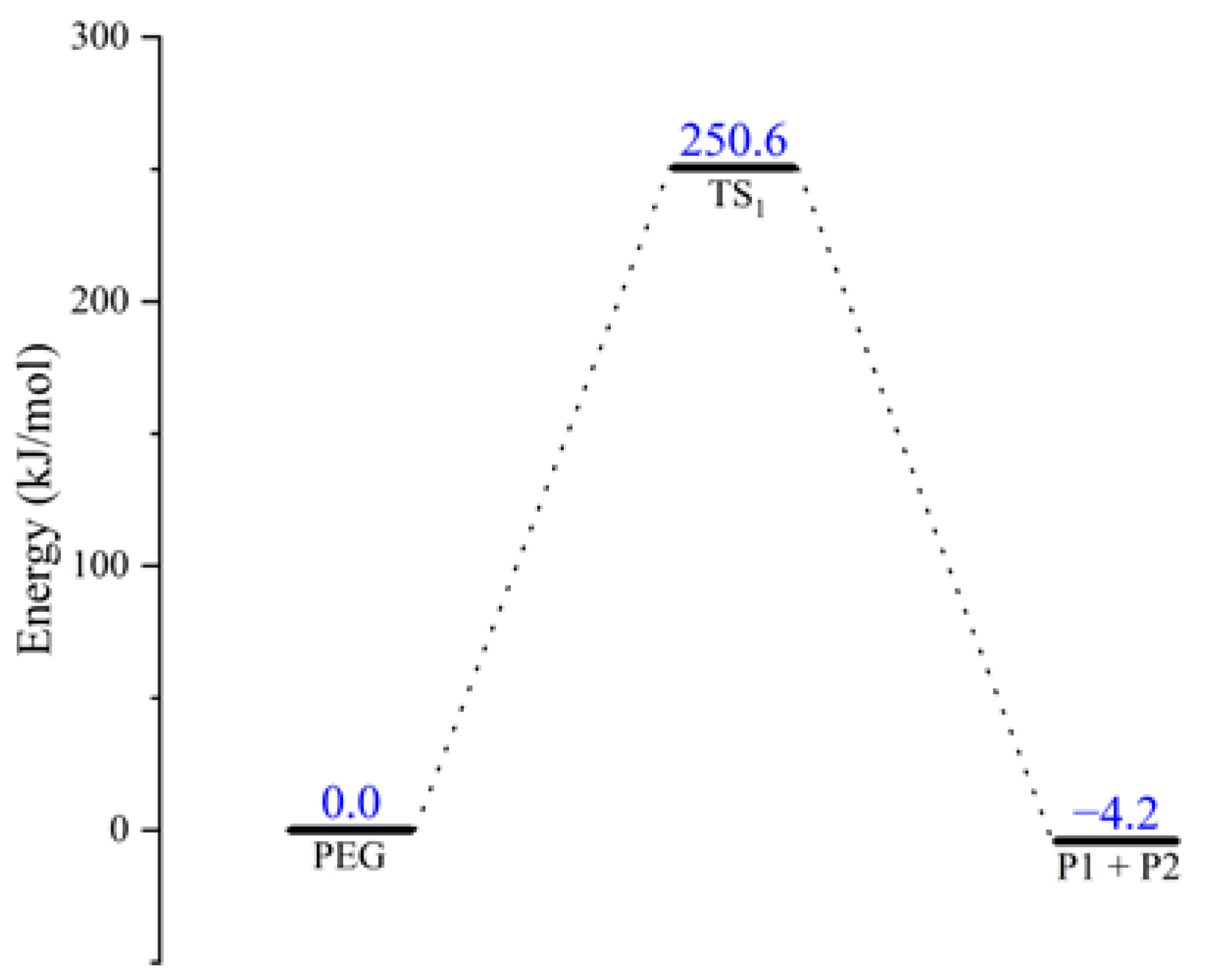
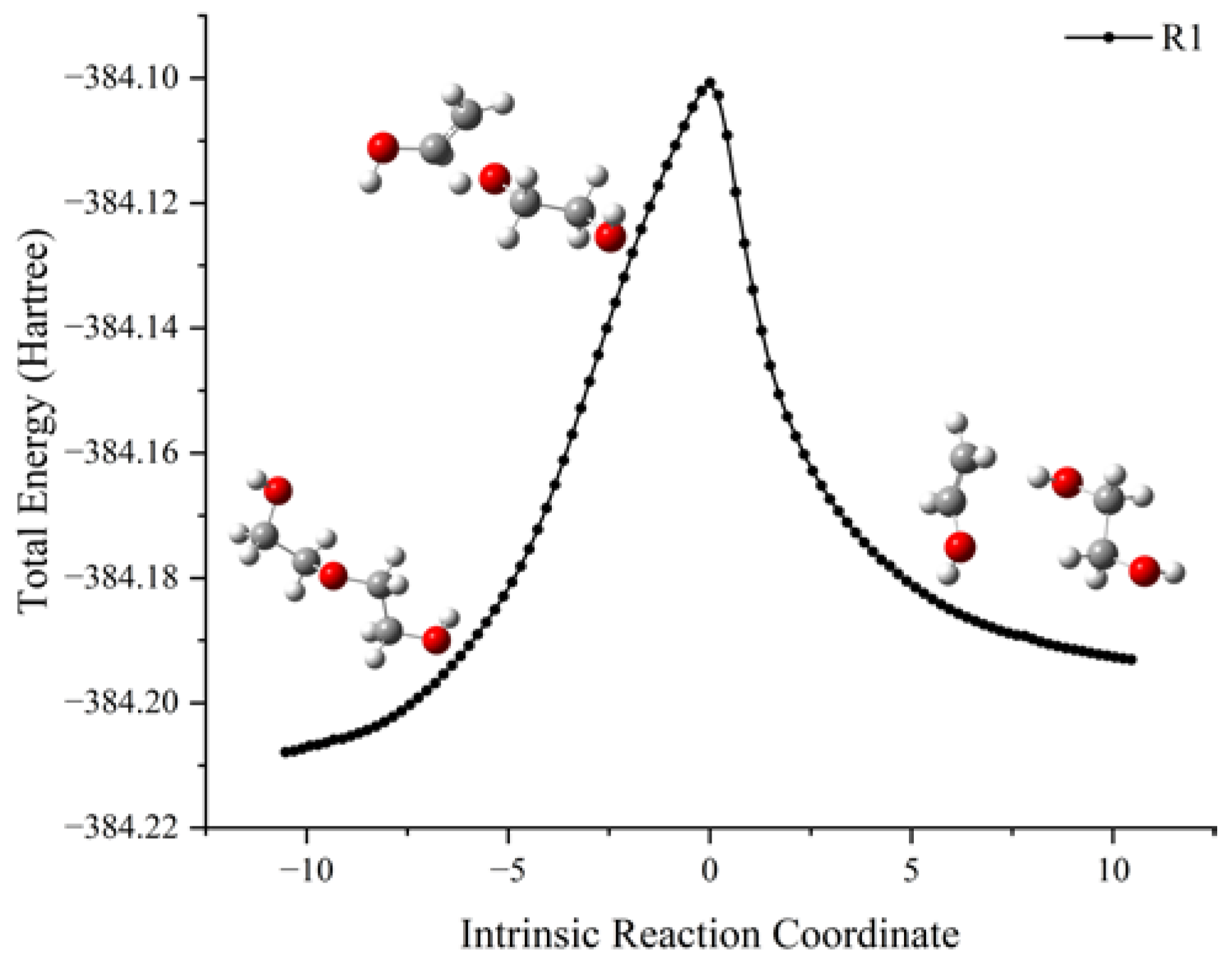
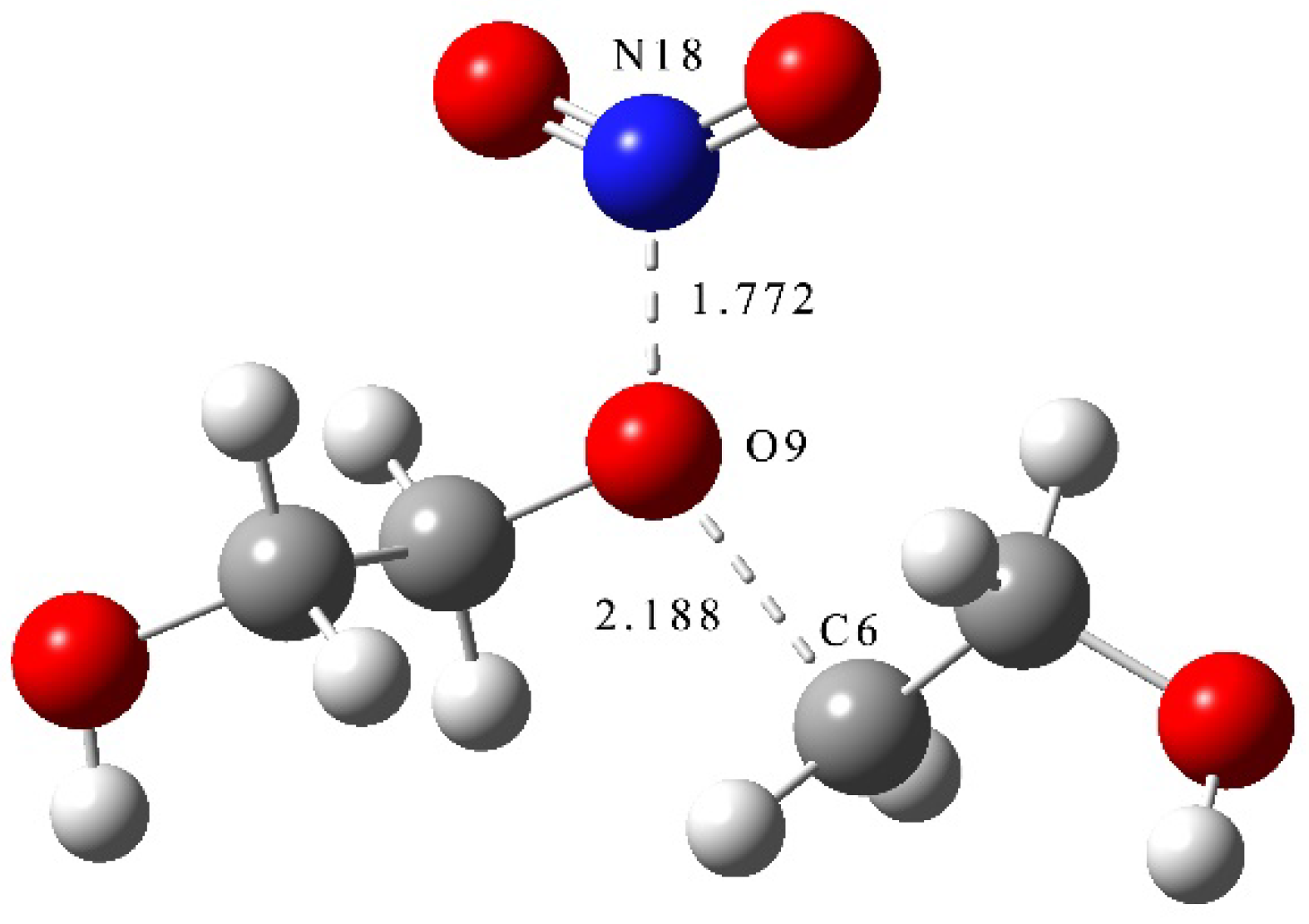
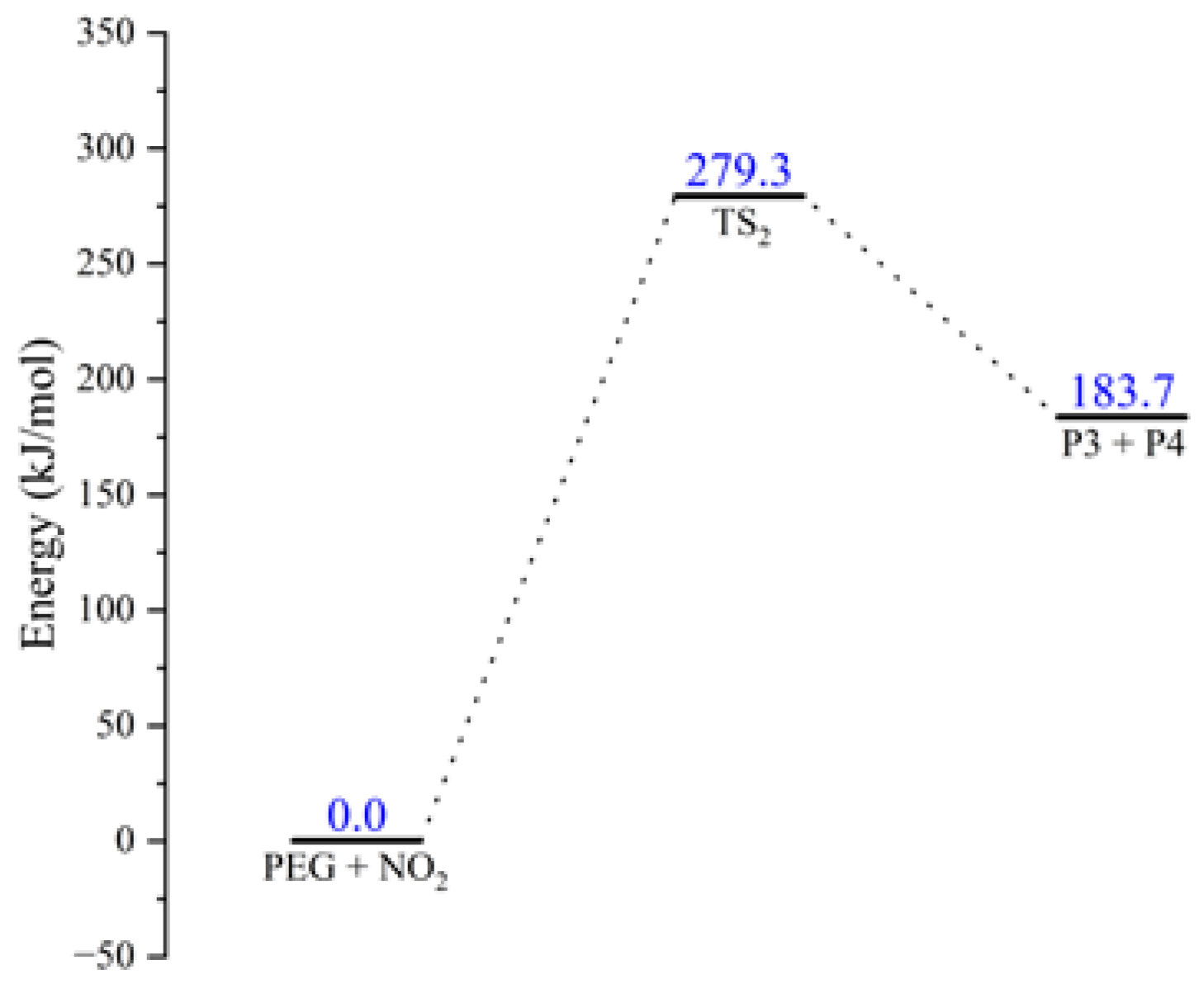

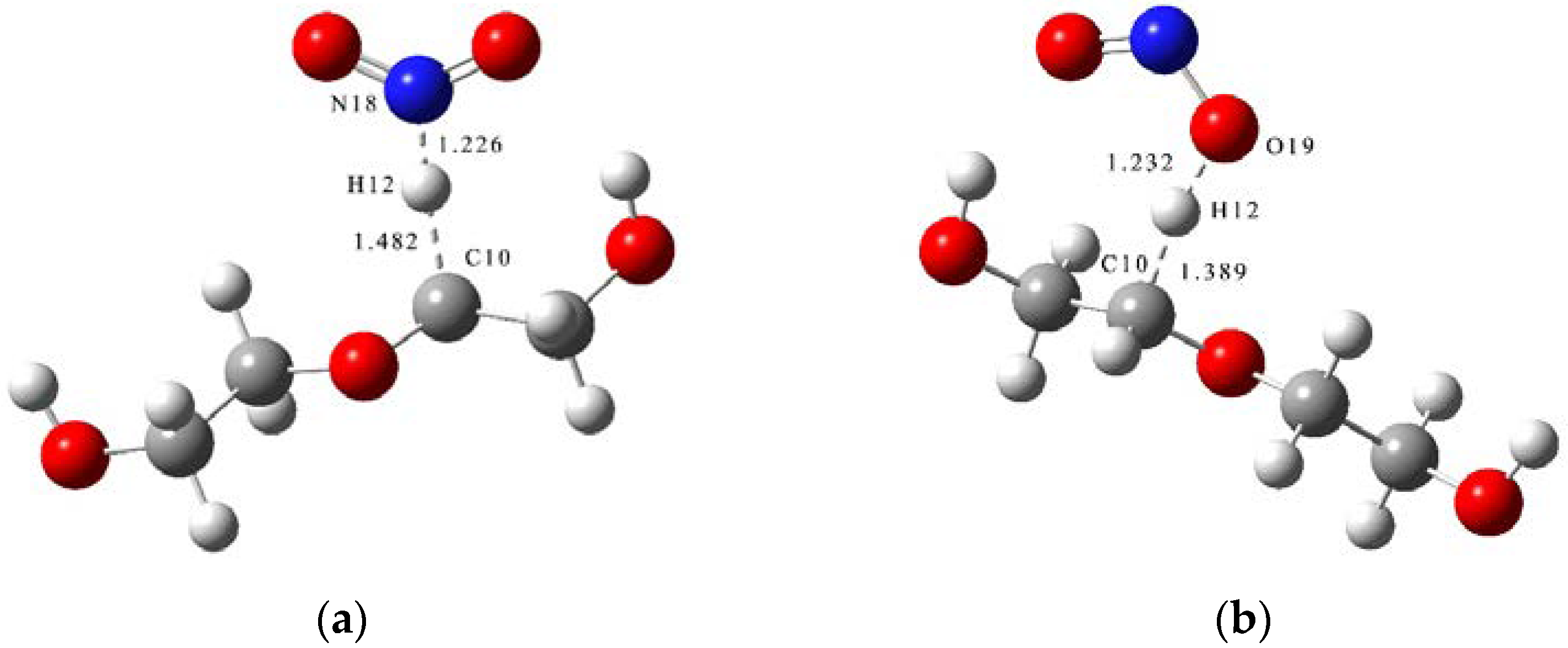

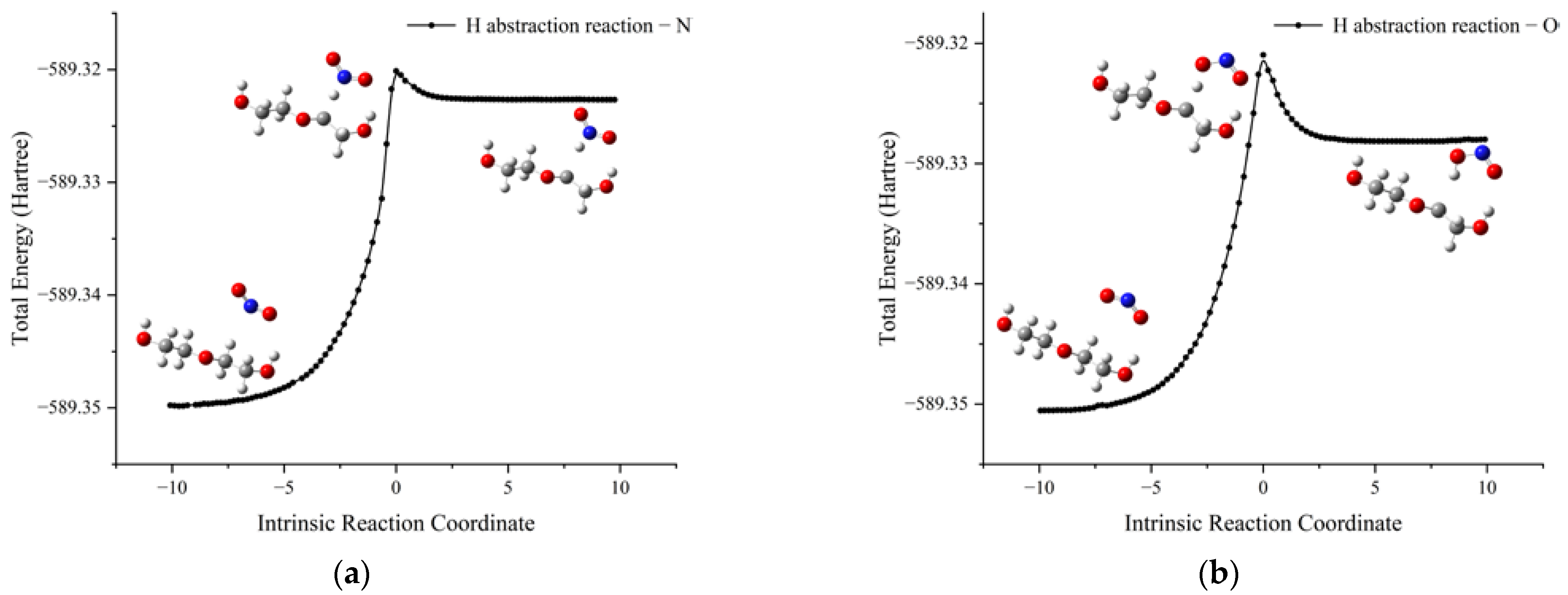
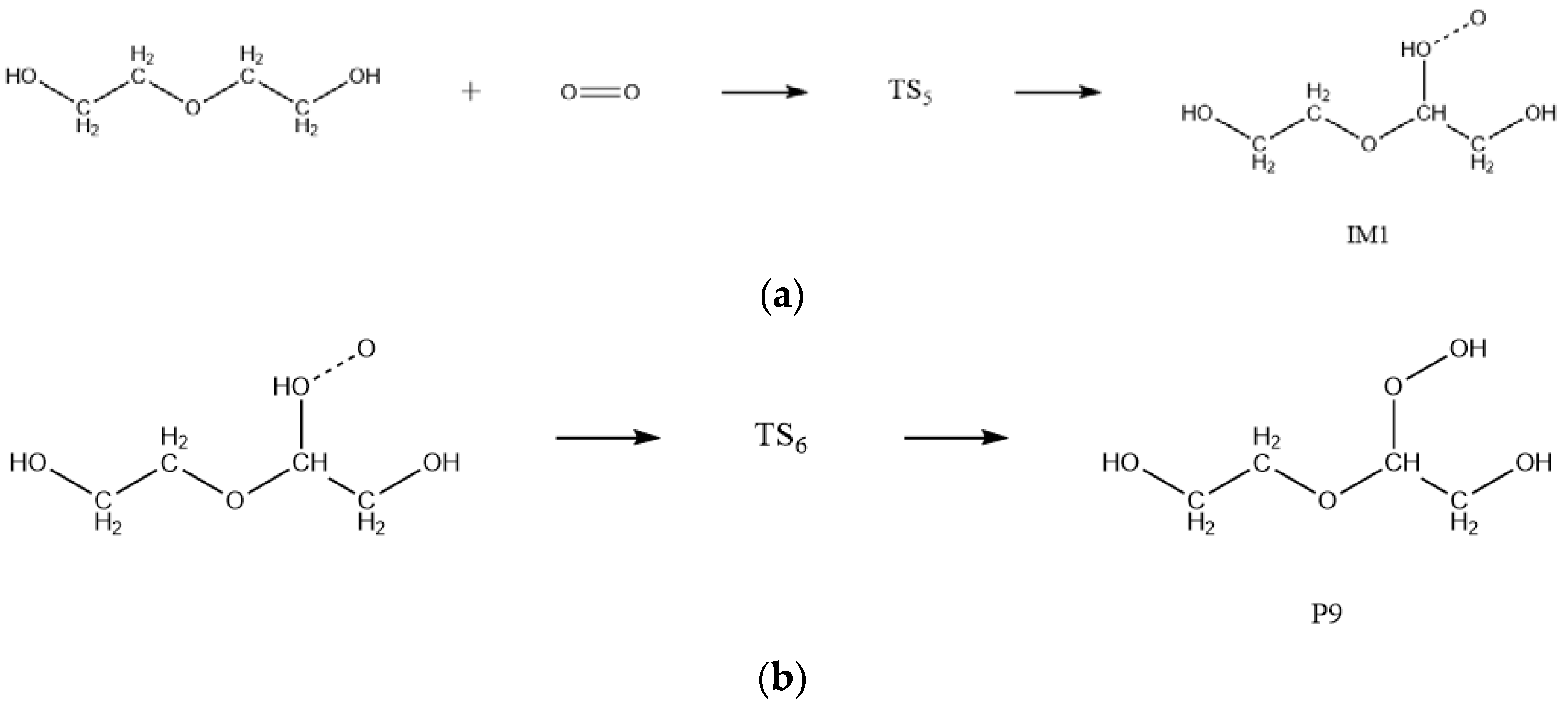
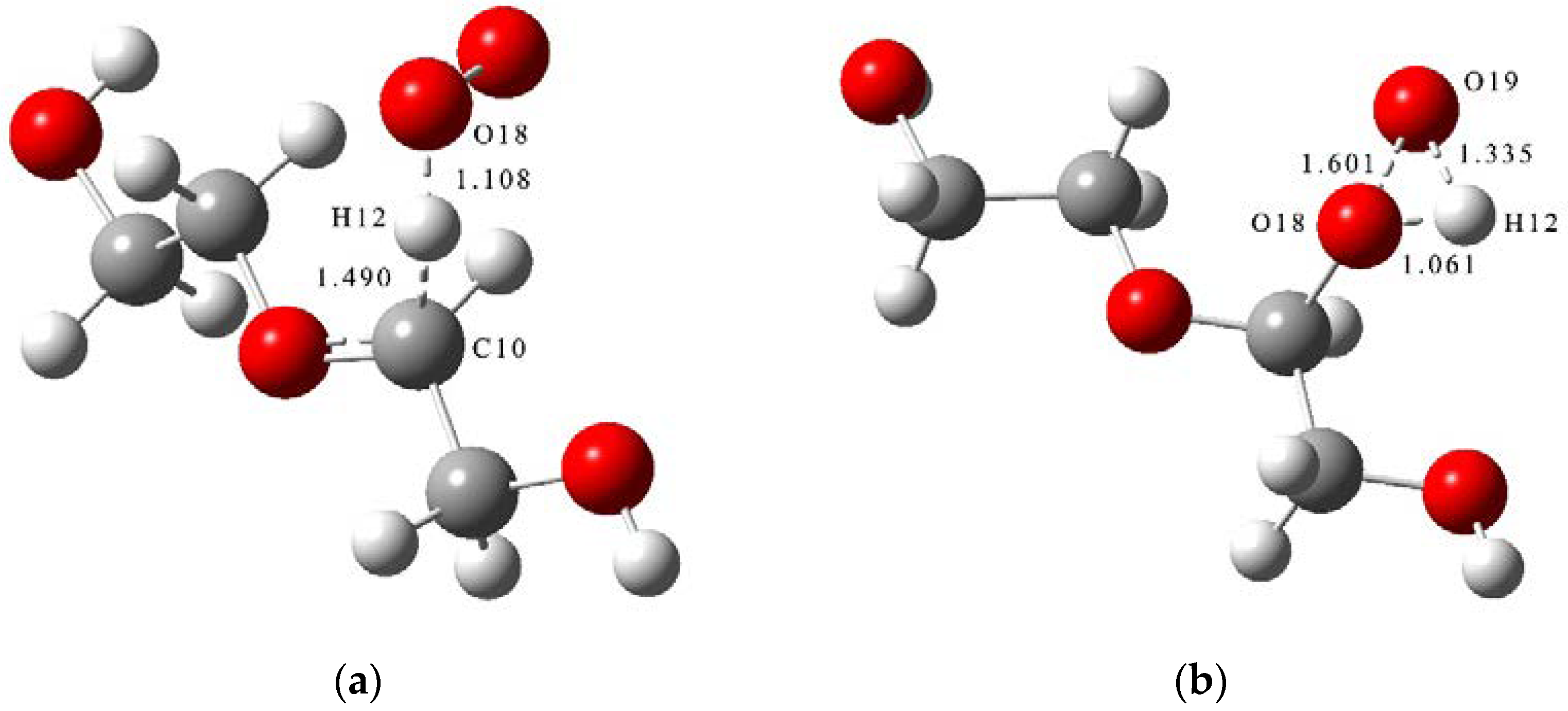

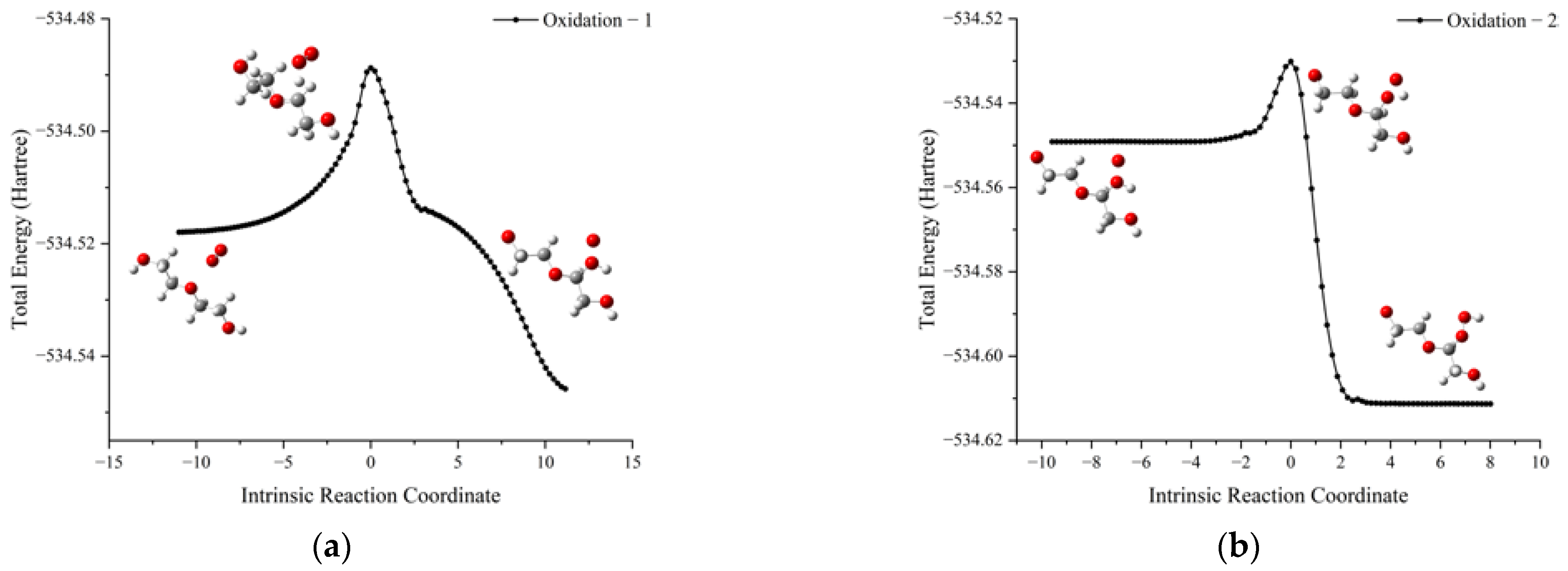


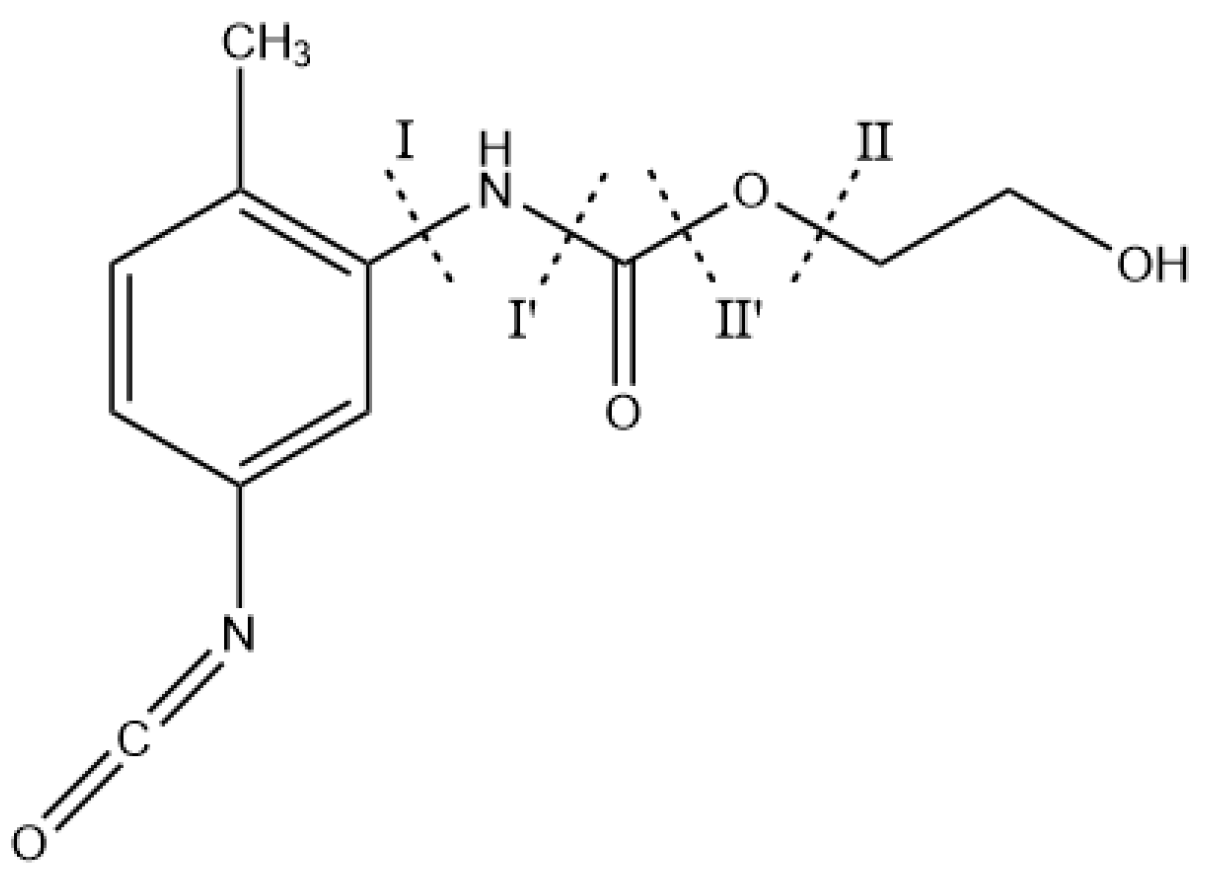
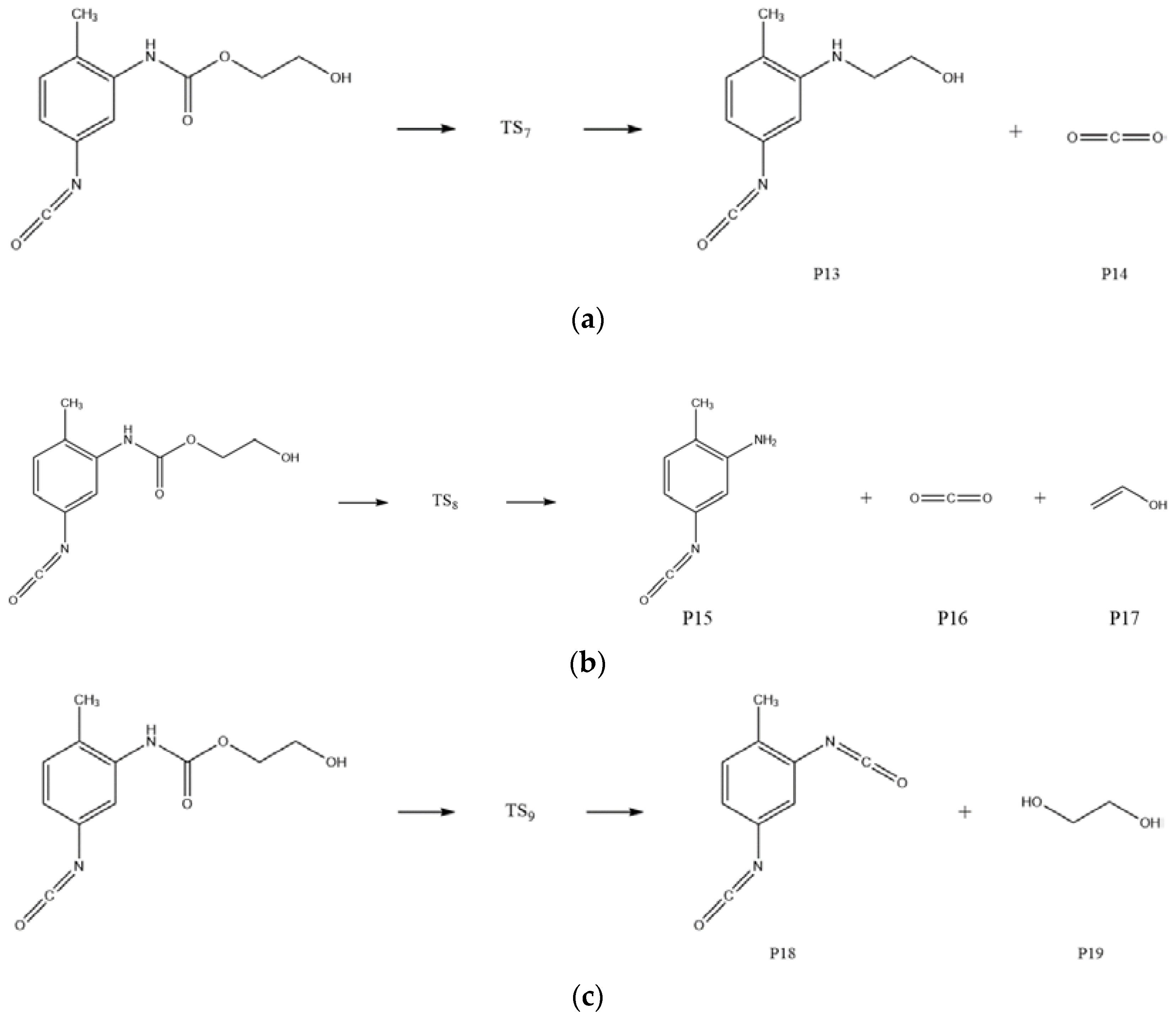
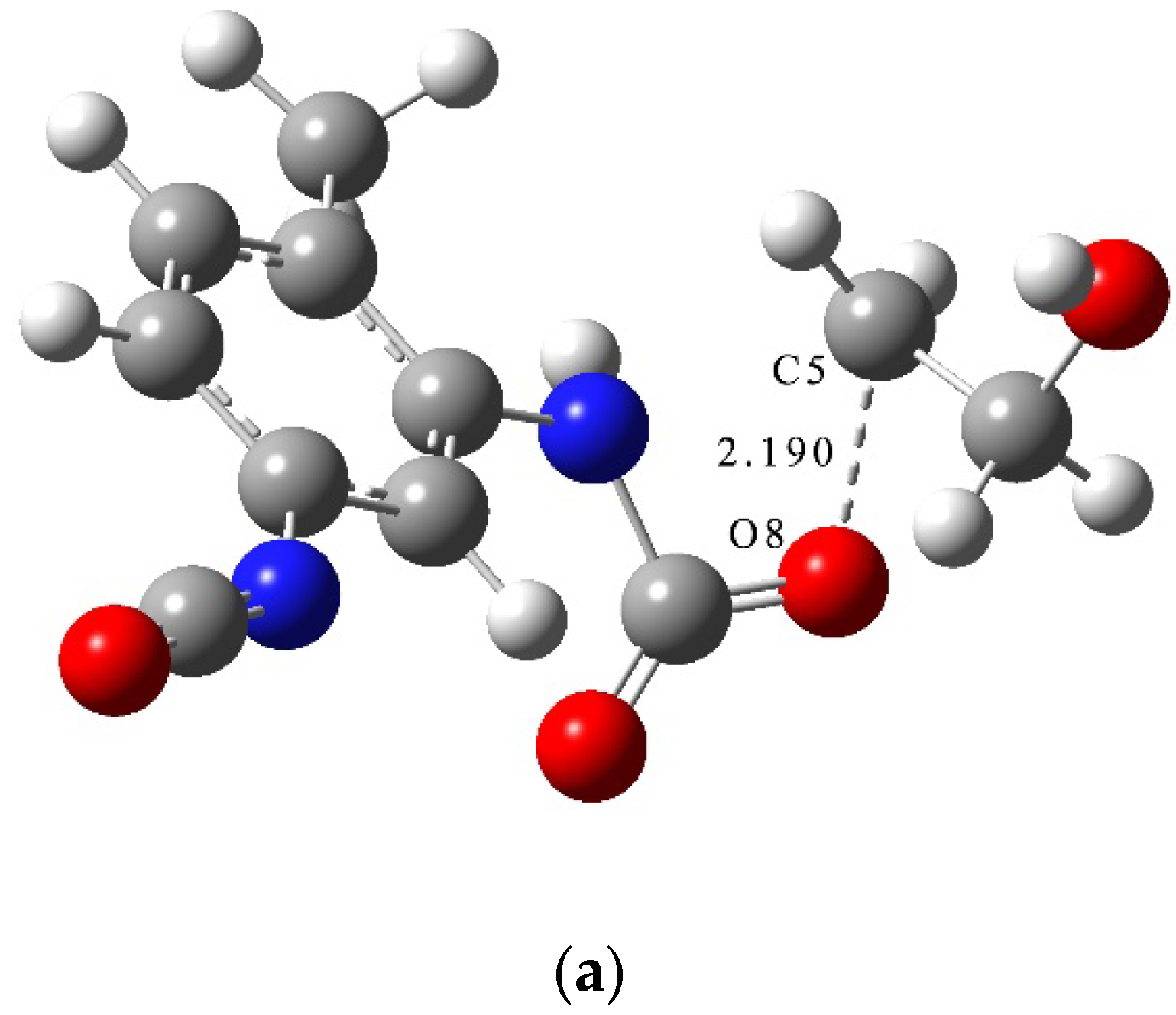
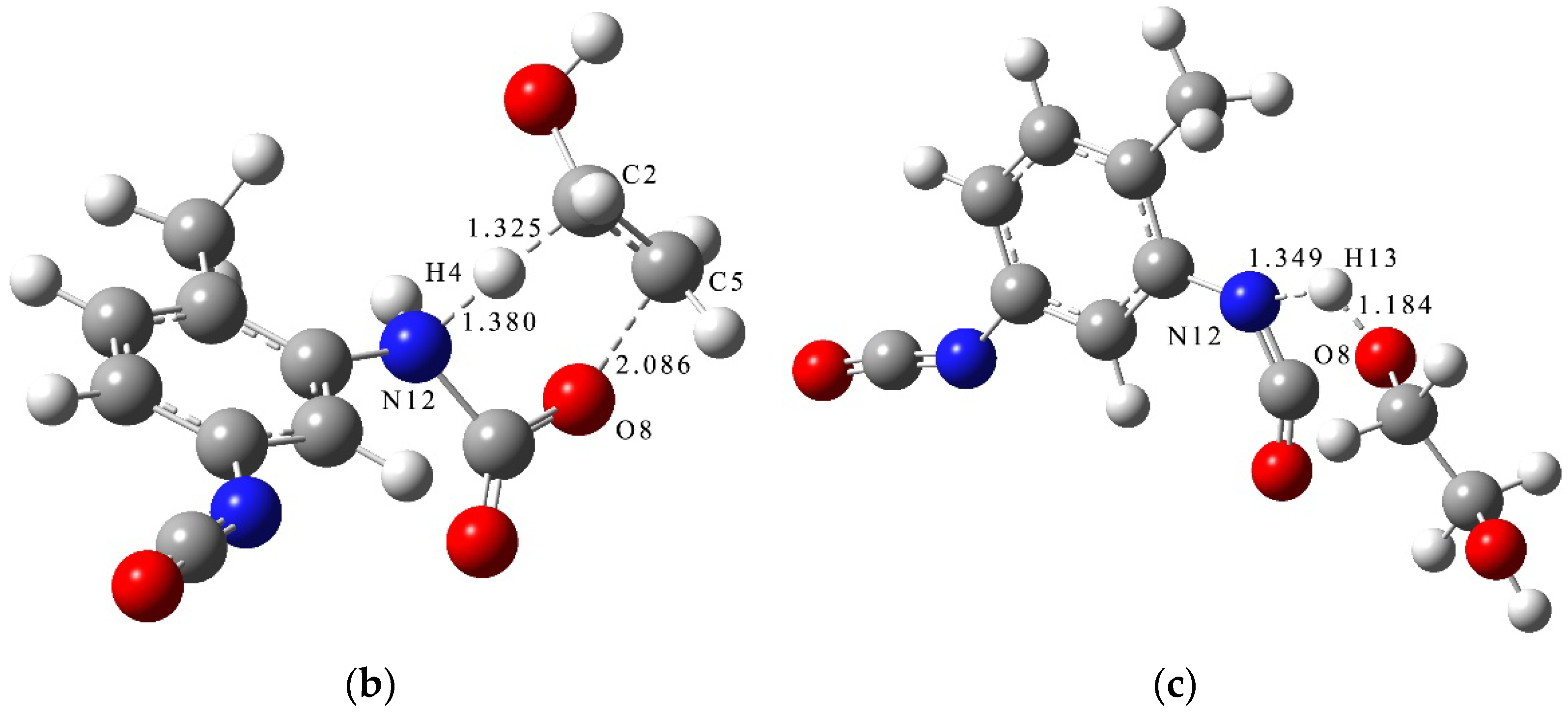
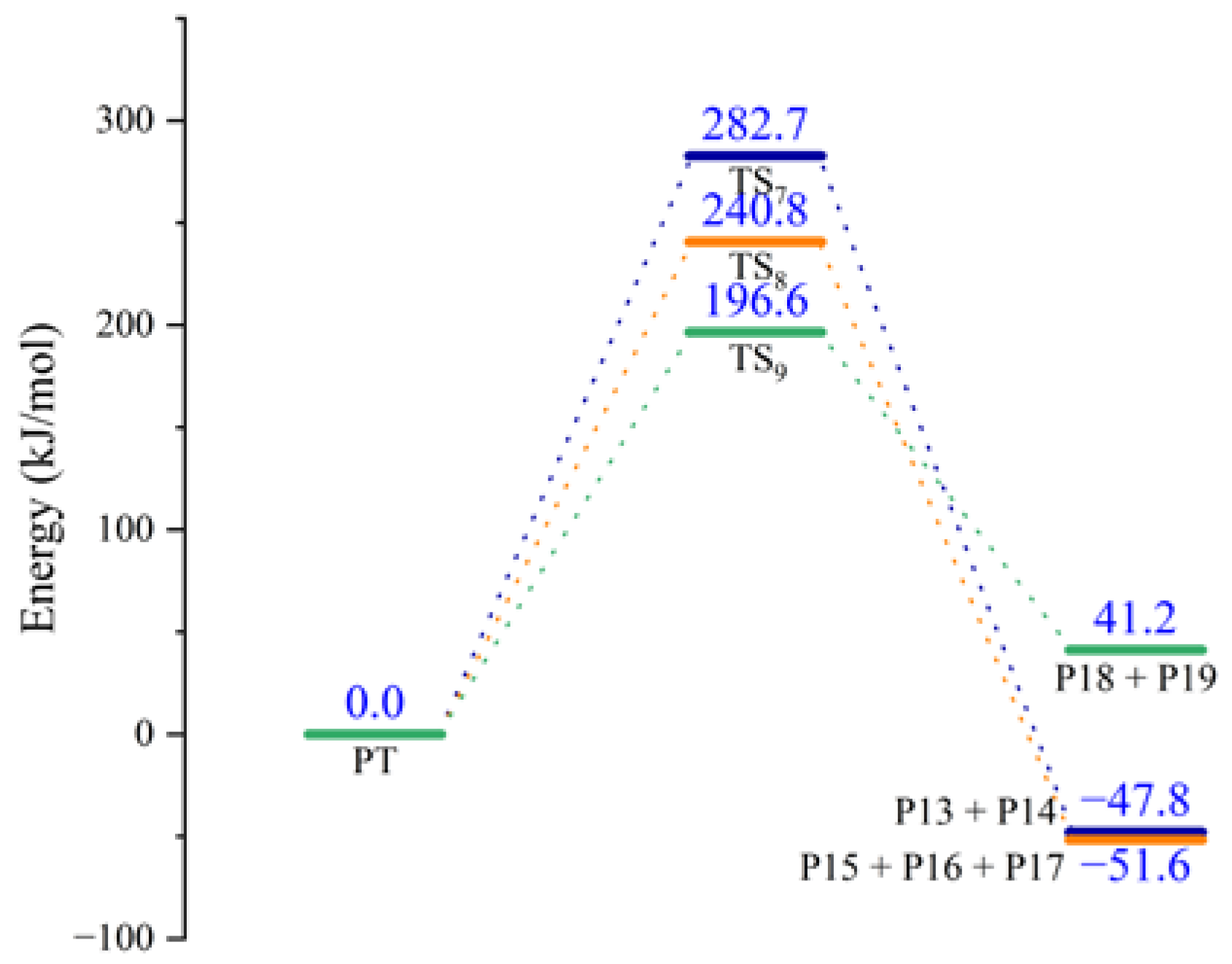
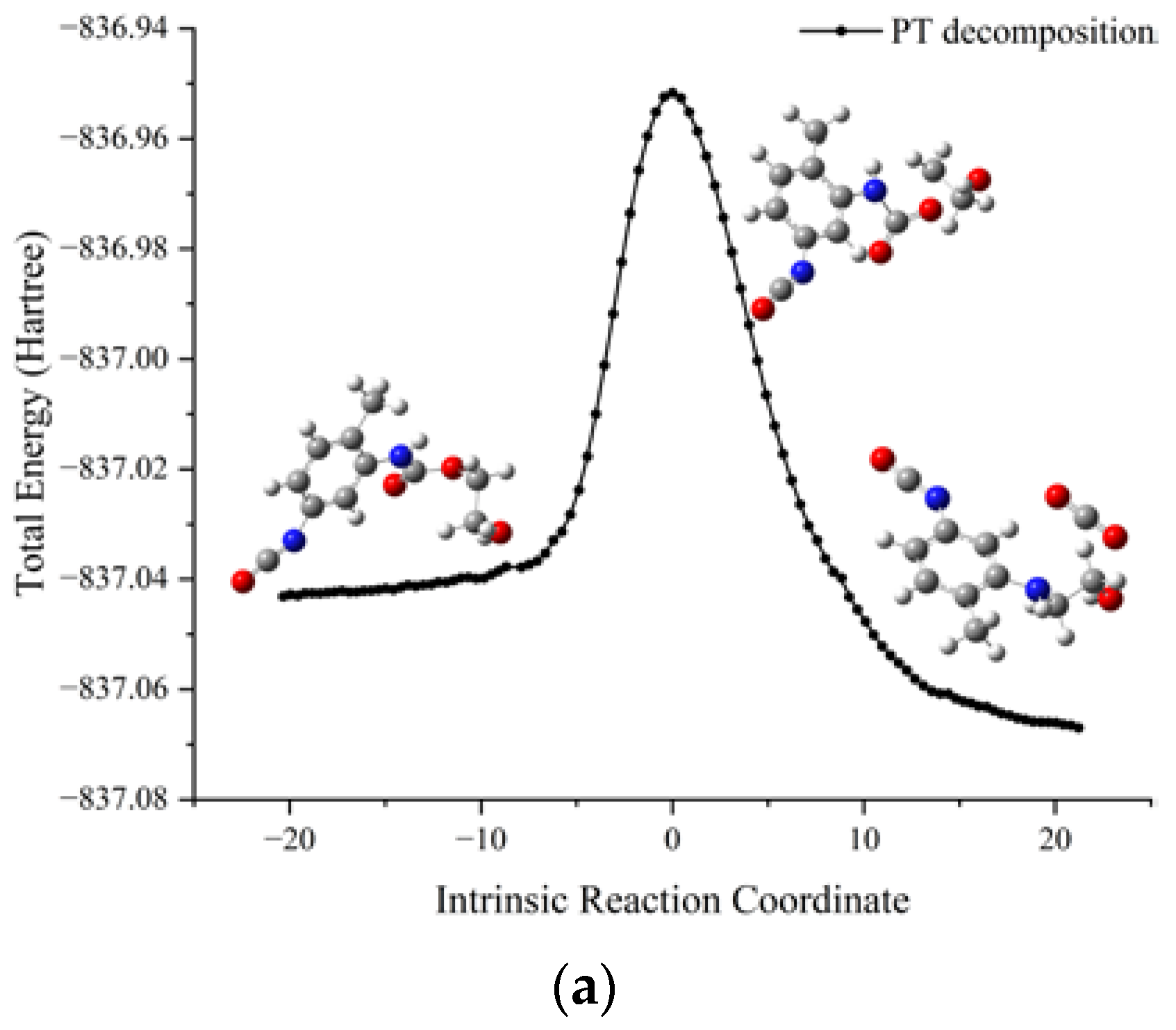
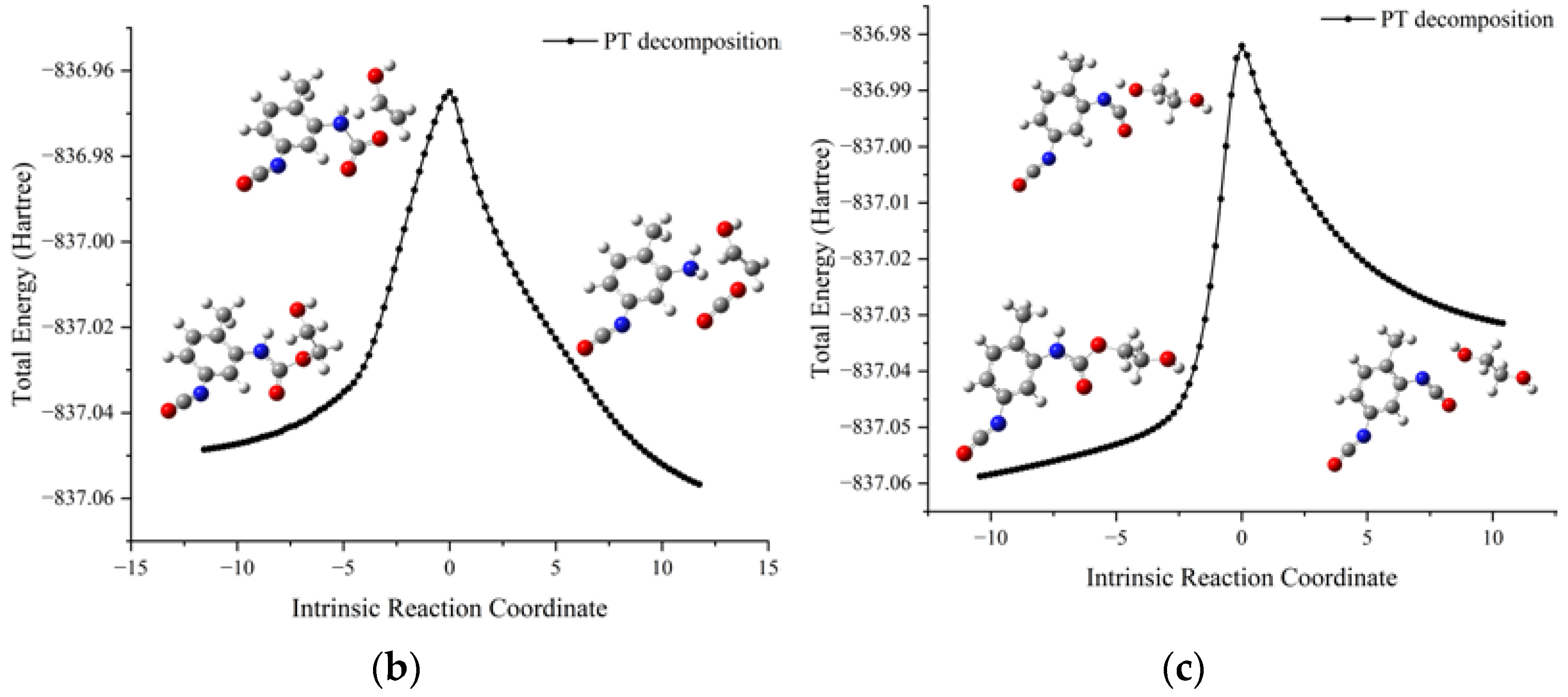
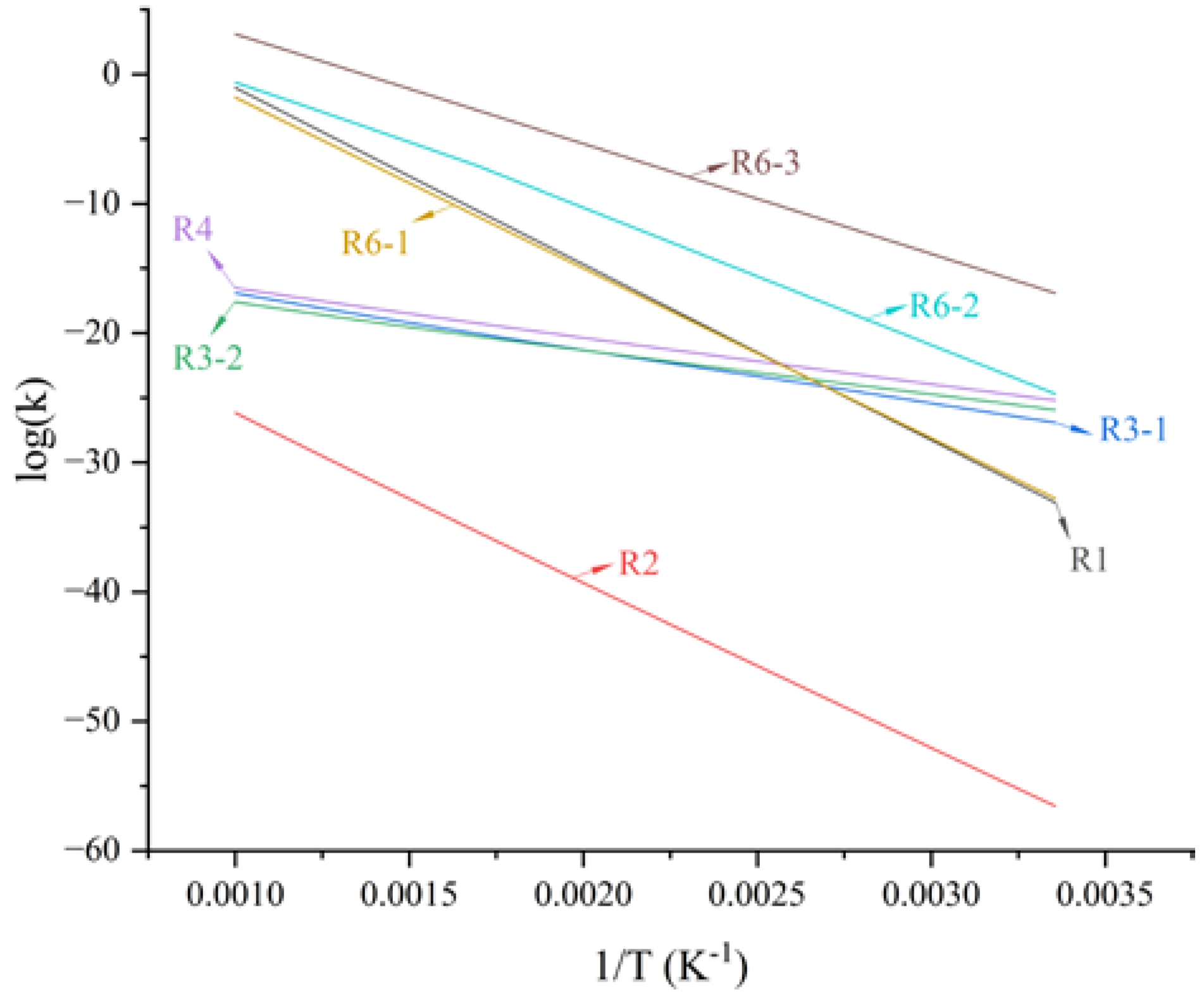
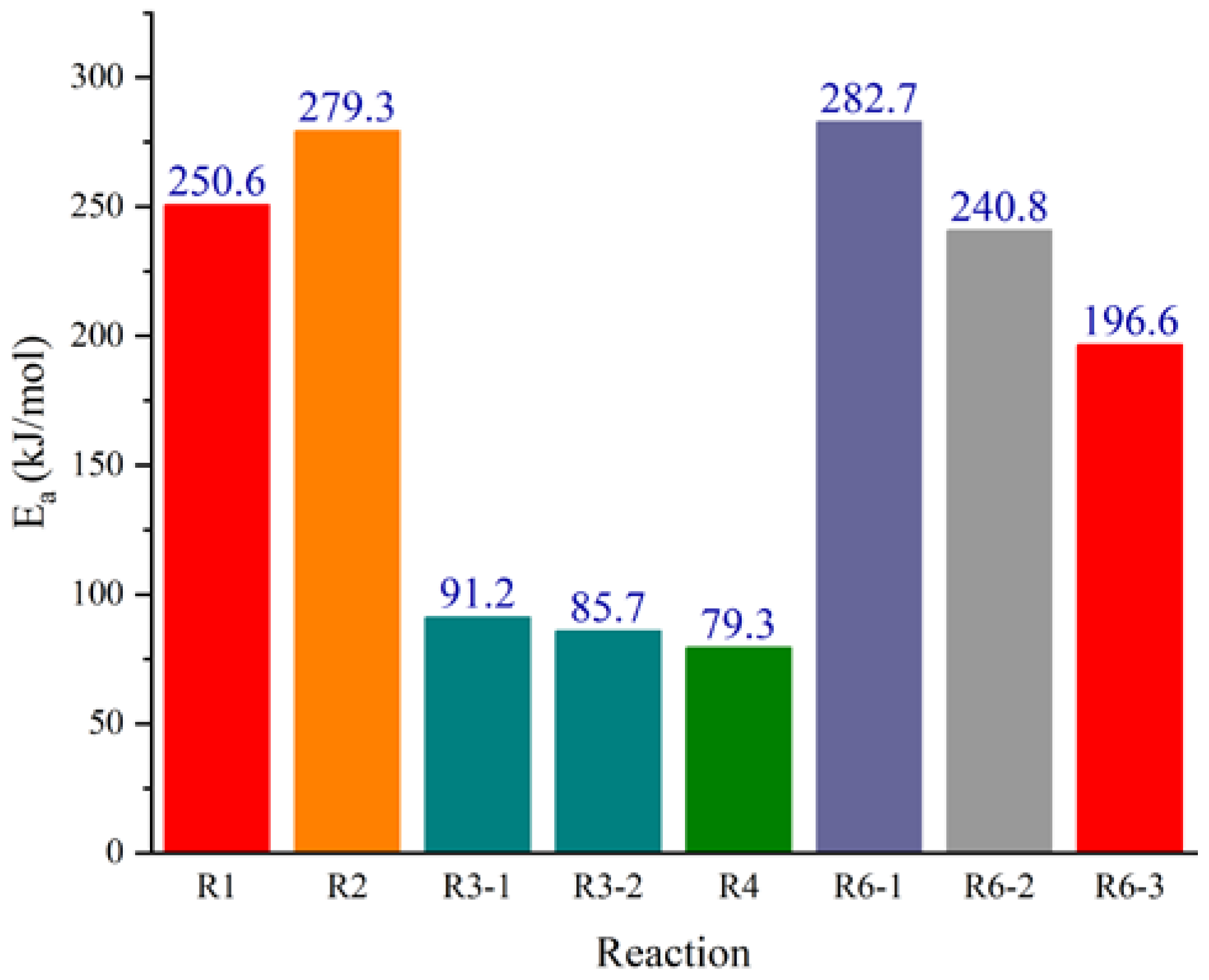
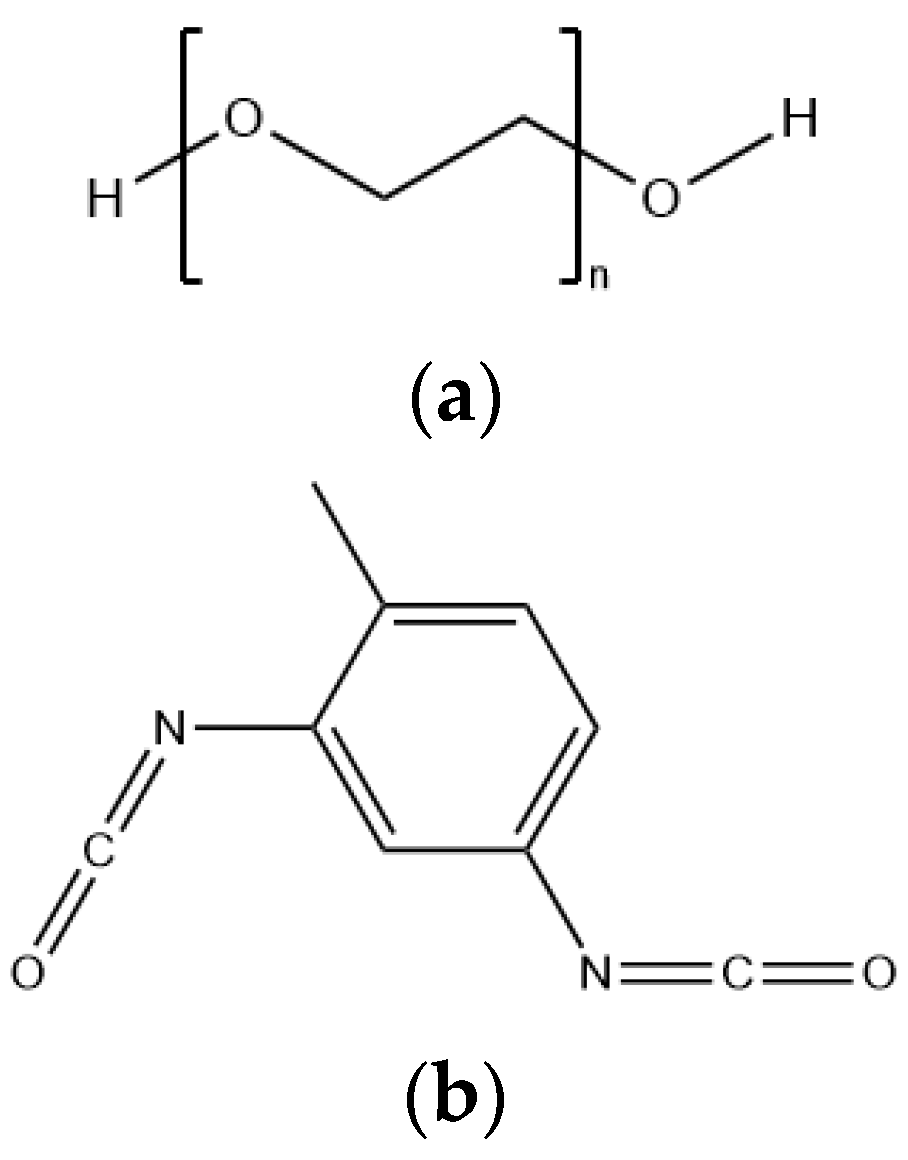
| Ⅰ | Ⅰ′ | Ⅱ | Ⅱ′ | |
|---|---|---|---|---|
| BDE/a.u. | 0.1072 | 0.0664 | 0.0635 | 0.0640 |
| Channel | A | n | Ea |
|---|---|---|---|
| R1 | 4.56 × 1011 | 0.2081 | 255.41 |
| R2 | 1.10 × 10−24 | 3.307 | 231.77 |
| R3-1 | 4.41 × 10−23 | 3.205 | 69.08 |
| R3-2 | 3.37 × 10−3 | −4.137 | 72.86 |
| R4 | 4.05 × 10−7 | −2.436 | 71.52 |
| R6-1 | 2.52 × 108 | 0.9143 | 247.13 |
| R6-2 | 2.64 × 1011 | −0.2207 | 200.52 |
| R6-3 | 7.78 × 1013 | −0.7818 | 161.56 |
Disclaimer/Publisher’s Note: The statements, opinions and data contained in all publications are solely those of the individual author(s) and contributor(s) and not of MDPI and/or the editor(s). MDPI and/or the editor(s) disclaim responsibility for any injury to people or property resulting from any ideas, methods, instructions or products referred to in the content. |
© 2023 by the authors. Licensee MDPI, Basel, Switzerland. This article is an open access article distributed under the terms and conditions of the Creative Commons Attribution (CC BY) license (https://creativecommons.org/licenses/by/4.0/).
Share and Cite
Kong, L.; Dong, K.; Tang, Y.; Yang, C.; Xiao, Y. Molecular Simulation Study on the Aging Mechanism of NEPE Propellant Matrix. Molecules 2023, 28, 1792. https://doi.org/10.3390/molecules28041792
Kong L, Dong K, Tang Y, Yang C, Xiao Y. Molecular Simulation Study on the Aging Mechanism of NEPE Propellant Matrix. Molecules. 2023; 28(4):1792. https://doi.org/10.3390/molecules28041792
Chicago/Turabian StyleKong, Lingze, Kehai Dong, Yanhui Tang, Chuanlu Yang, and Yundong Xiao. 2023. "Molecular Simulation Study on the Aging Mechanism of NEPE Propellant Matrix" Molecules 28, no. 4: 1792. https://doi.org/10.3390/molecules28041792
APA StyleKong, L., Dong, K., Tang, Y., Yang, C., & Xiao, Y. (2023). Molecular Simulation Study on the Aging Mechanism of NEPE Propellant Matrix. Molecules, 28(4), 1792. https://doi.org/10.3390/molecules28041792







